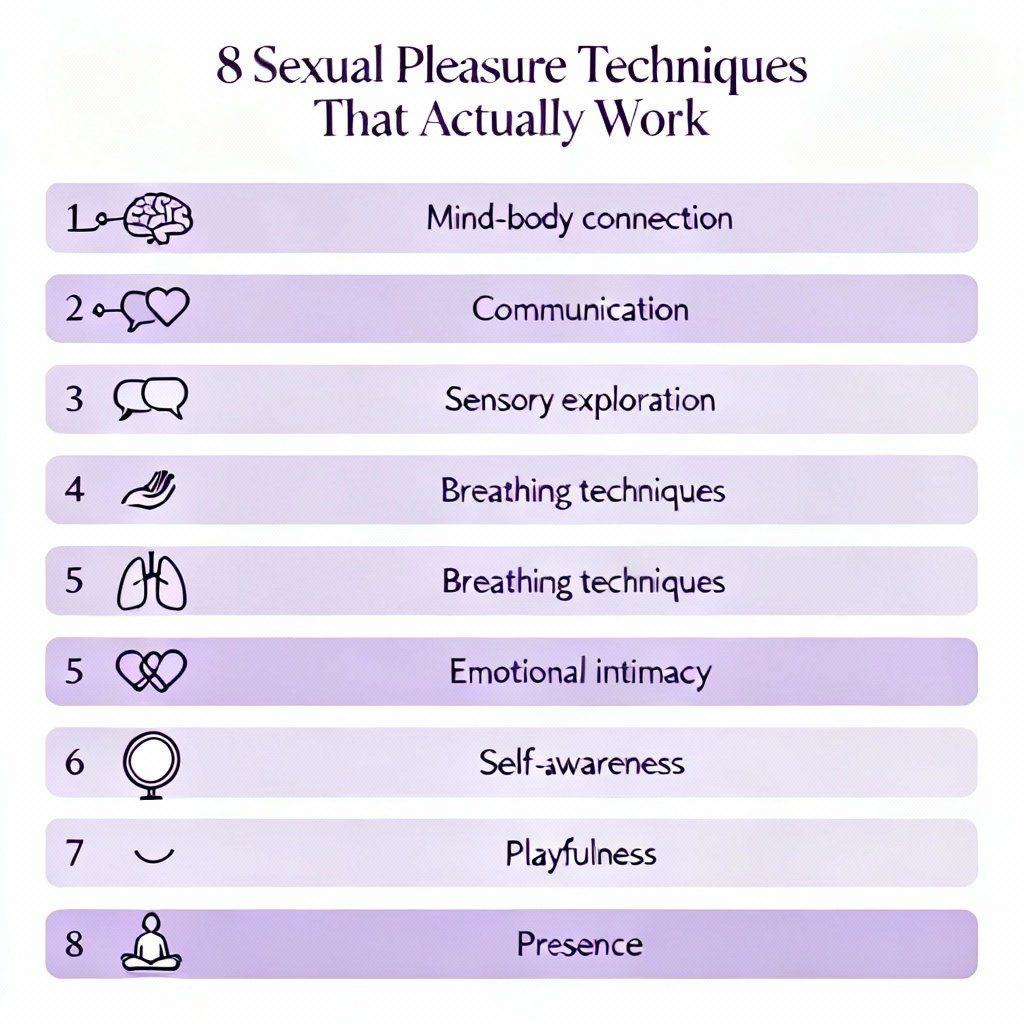Sexual Pleasure Techniques: A Real, Honest Guide to Enhancing Intimacy & Wellness
Let’s talk about something most people whisper about but rarely discuss openly: sexual pleasure. Not the sanitized, clinical version you might find in a textbook. Not the performative, unrealistic version you see in movies. The real, messy, beautiful, complicated truth about what it means to experience and enhance sexual pleasure.
I think it’s crucial to start by defining what we mean by sexual pleasure and desire. These are fundamental aspects of the human experience, and they encompass much more than physical sensations. Sexual pleasure can involve a complex combination of emotional fulfillment, intimate connection, and bodily enjoyment.
Here’s what nobody tells you: sexual pleasure isn’t just about orgasms. It’s about feeling safe enough to be vulnerable. It’s about discovering what your body responds to. It’s about communicating desires you might not even fully understand yet. And yes, it’s also about the physical techniques that can transform good sex into mind-blowing intimacy.
Whether you’re exploring pleasure solo, with a long-term partner, or in a new relationship, this guide will give you practical, science-backed, shame-free strategies to enhance your sexual wellness. We’re going to talk about techniques that actually work, how to communicate what you need, and why sexual pleasure matters for your mental health and overall wellbeing.
Here’s what we’ll explore:
Table of Contents
- 🔥 What Is Sexual Pleasure? (Beyond the Physical)
- 💜 Sexual Pleasure Techniques for Couples That Actually Work
- ✨ How to Enhance Sexual Pleasure for Women
- 🧠 Sexual Pleasure and Mental Health: The Science of Satisfaction
- 💬 How to Talk About Sexual Pleasure (Without Awkwardness)
- 🌸 Sexual Pleasure Self-Care: Owning Your Desires
- 🌿 Sexual Pleasure and Wellness: The Holistic Approach
- 🚀 How to Increase Sexual Pleasure: Advanced Strategies
- ❓ FAQ: Your Sexual Pleasure Questions Answered
What Is Sexual Pleasure? (Beyond the Physical)
Sexual pleasure is one of those things everyone experiences differently, yet we’re all supposed to somehow instinctively know what it means. Spoiler alert: most of us don’t.
At its core, sexual pleasure is the positive physical, emotional, and psychological experience that comes from sexual activity—whether solo or partnered. But here’s where it gets interesting: what feels pleasurable to you might be completely different from what works for someone else. And that’s not just okay—it’s exactly how it should be.
The Three Dimensions of Sexual Pleasure
1. Physical Pleasure: This is the sensory experience—touch, temperature, pressure, rhythm, and yes, orgasm. But physical pleasure isn’t limited to genitals. Your entire body is capable of experiencing sexual sensation. The nape of your neck, your inner thighs, your scalp, your feet—these are all potential sources of pleasure when you’re tuned in.
2. Emotional Pleasure: This is about feeling desired, safe, connected, and seen by your partner. It’s the warmth that spreads through your chest when your partner looks at you with genuine want. It’s the trust that allows you to be completely vulnerable. Emotional pleasure is what transforms physical touch into true intimacy.
3. Mental Pleasure: This is where fantasy, anticipation, and psychological arousal live. Your brain is your most powerful sexual organ. Mental pleasure is what happens when you’re thinking about your partner hours before you see them. It’s the thrill of trying something new. It’s the narrative you create around your sexual experiences.
Why Sexual Pleasure Matters
Sexual pleasure isn’t frivolous or selfish—it’s fundamental to human wellbeing. Research shows that satisfying sexual experiences:
- Strengthen relationship bonds through oxytocin release (the “bonding hormone”)
- Reduce stress and anxiety by lowering cortisol levels
- Improve sleep quality through the release of prolactin
- Boost immune function and overall physical health
- Enhance self-esteem and body confidence
- Increase emotional intimacy and communication in relationships
When you prioritize sexual pleasure—yours and your partner’s—you’re not being indulgent. You’re investing in your relationship, your mental health, and your overall quality of life.
Sexual Pleasure Techniques for Couples That Actually Work
Now let’s get practical. These aren’t gimmicks or performative moves you saw in a movie. These are evidence-based, real-world techniques that enhance pleasure for both partners.
1. Mindful Breathing & Presence
Most people hold their breath or breathe shallowly during sex, especially as arousal builds. This actually limits pleasure by creating tension and reducing oxygen flow.
Try this: Synchronize your breathing with your partner’s. Breathe deeply into your belly, not your chest. As arousal intensifies, consciously slow your breathing rather than speeding it up. This keeps you present, reduces performance anxiety, and can actually intensify orgasms.
2. Sensory Exploration Beyond Erogenous Zones
We get so focused on the “main event” that we skip over the journey. Your skin has over 5 million nerve endings—use them.
Try this: Spend 10 minutes touching your partner everywhere except their genitals. Use different textures—fingertips, palms, breath, hair, fabric. Notice what makes them shiver, sigh, or lean into your touch. This builds anticipation and expands your pleasure map beyond the obvious zones.
3. The Art of Edging & Anticipation
Edging—bringing yourself or your partner close to orgasm, then backing off—isn’t just a technique. It’s a way to extend pleasure, build intensity, and create more powerful climaxes.
Try this: Use a scale of 1-10, where 10 is orgasm. Bring yourself or your partner to an 8, then drop back to a 5. Repeat 3-4 times before allowing release. The buildup creates a more intense experience and teaches you to recognize and communicate arousal levels.
4. Fantasy Sharing & Verbal Intimacy
Talking during sex isn’t just dirty talk (though that works too). It’s about creating a shared mental space that enhances physical sensation.
Try this: Share a fantasy—even a mild one—while being intimate. “I love imagining…” or “I’ve been thinking about…” This creates psychological arousal that amplifies physical pleasure. Start small and build trust before diving into deeper fantasies.
5. Extended Foreplay (The 20-Minute Rule)
Here’s a truth bomb: most couples spend 5-10 minutes on foreplay. Research shows that women, in particular, need 20+ minutes of arousal for optimal pleasure and orgasm potential.
Try this: Set a timer for 20 minutes where penetration is off the table. Focus entirely on kissing, touching, oral pleasure, and building arousal. You’ll be amazed at how this changes the entire experience. For more comprehensive guidance, explore our 500 lovemaking tips.
6. Rhythmic Variation & Pressure Play
Monotonous rhythm is the enemy of sustained pleasure. Your body adapts to repetitive stimulation, which can actually decrease sensation over time.
Try this: Vary your rhythm, pressure, and speed. Try the “rule of three”—three slow strokes, one fast. Three light touches, one firm. This keeps nerve endings responsive and arousal building.
7. Full-Body Pleasure Mapping
Take turns being the “explorer” and the “map.” The explorer touches different areas while the map rates pleasure on a scale of 1-10.
Try this: Discover unexpected pleasure zones—behind the knees, inner elbows, lower back, scalp. Create a literal map of what works for each of you. This removes guesswork and builds a personalized pleasure blueprint.
8. Post-Intimacy Connection
What happens after sex matters as much as what happens during. The post-orgasm period is when bonding hormones are highest.
Try this: Stay physically connected for 5-10 minutes after. Talk, cuddle, make eye contact. This reinforces emotional intimacy and makes your partner feel valued beyond the physical act.

How to Enhance Sexual Pleasure for Women
Women’s sexual pleasure has been misunderstood, dismissed, and frankly ignored for far too long. Let’s set the record straight with what actually works.
Understanding Female Arousal
Female arousal isn’t linear—it’s cyclical and responsive. Unlike the relatively straightforward male arousal pattern, women’s arousal can ebb and flow throughout a sexual encounter. This isn’t a problem; it’s just how it works.
Women often need mental and emotional arousal before physical arousal kicks in. This means feeling safe, desired, relaxed, and mentally engaged. Stress, distraction, and feeling rushed are arousal killers.
The Clitoral-Vaginal Pleasure Connection
Here’s a stat that should be common knowledge but isn’t: only 18-25% of women can orgasm from penetration alone. The vast majority need clitoral stimulation.
The clitoris has over 8,000 nerve endings (twice as many as the penis) and extends internally around the vaginal opening. This means that what feels like “vaginal” pleasure is often actually internal clitoral stimulation.
What this means practically: Incorporate clitoral stimulation during penetration. Use hands, toys, or positions that create friction. Don’t treat clitoral pleasure as “foreplay”—it’s the main event. For detailed techniques, check out our guide on lovemaking for women.
Creating Emotional Safety
Women’s arousal is deeply connected to feeling emotionally safe. This means:
- Knowing you won’t be judged for your desires or your body
- Trusting your partner to respect your boundaries
- Feeling desired for who you are, not just what you look like
- Being able to communicate without fear of rejection
Partners: if you want to enhance your partner’s pleasure, start by creating an environment where she feels completely safe to be vulnerable.
The Role of Mental Arousal
For many women, mental arousal precedes and enhances physical arousal. This is why romance novels, anticipation, and emotional connection are so powerful.
Try this: Build anticipation throughout the day with texts, touches, or suggestive comments. Create mental arousal before physical touch even begins. Women who explore the pleasure principle often discover that their most powerful sexual organ is their mind.
Ready to Transform Your Intimate Life?
Discover 500 proven lovemaking tips that will help you and your partner experience deeper pleasure, stronger connection, and more satisfying intimacy.
Real techniques for real couples who want extraordinary intimacy
Sexual Pleasure and Mental Health: The Science of Satisfaction
Sexual pleasure isn’t separate from mental health—it’s deeply intertwined with it. Understanding this connection can transform how you approach both.
The Neurochemistry of Pleasure
During sexual arousal and orgasm, your brain releases a cocktail of feel-good chemicals:
- Dopamine: The “reward” neurotransmitter that creates motivation and pleasure
- Oxytocin: The “bonding hormone” that creates feelings of attachment and trust
- Endorphins: Natural painkillers that create euphoria and reduce stress
- Serotonin: The mood regulator that promotes feelings of wellbeing
- Prolactin: The relaxation hormone that promotes sleep and satisfaction
This isn’t just “feeling good”—it’s your brain literally rewiring itself for connection, stress relief, and emotional regulation.
Stress Reduction & Sexual Wellness
Chronic stress is one of the biggest killers of sexual desire and pleasure. When you’re in “fight or flight” mode, your body diverts resources away from sexual function.
But here’s the paradox: sexual pleasure is one of the most effective stress relievers available. Regular sexual activity (solo or partnered) can:
- Lower cortisol (stress hormone) levels
- Improve sleep quality
- Reduce anxiety and depression symptoms
- Boost immune function
- Increase overall life satisfaction
The key is breaking the cycle. Even when you don’t “feel like it,” engaging in pleasurable touch can shift your nervous system out of stress mode.
Pleasure as Self-Care
We’ve normalized the idea that self-care is bubble baths and face masks. But sexual pleasure—especially solo pleasure—is one of the most powerful forms of self-care available.
Masturbation isn’t just about physical release. It’s about:
- Learning what your body responds to
- Practicing self-love and body acceptance
- Regulating your nervous system
- Maintaining sexual function and desire
- Reducing dependence on a partner for pleasure
When you understand your own pleasure, you can better communicate it to a partner. This creates a foundation for deeper intimacy in your relationship.
How to Talk About Sexual Pleasure (Without Awkwardness)
Communication is the difference between mediocre sex and mind-blowing intimacy. Yet most couples would rather endure unsatisfying sex than have an honest conversation about it.
Let’s fix that.
Starting the Conversation
The biggest mistake people make is trying to have “the talk” in the bedroom, in the moment. That’s the worst possible time.
Instead, try this:
- Choose a relaxed, non-sexual setting (over coffee, during a walk)
- Frame it positively: “I love our intimacy and I’d love to make it even better”
- Start with what’s working: “I love when you…”
- Then introduce what you’d like to explore: “I’ve been curious about…”
This approach feels like an invitation to grow together, not a criticism of what’s lacking.
Using “I” Statements
The difference between “You never…” and “I feel…” is massive.
Instead of: “You don’t spend enough time on foreplay”
Try: “I feel more aroused when we take our time with foreplay”
Instead of: “You’re too rough”
Try: “I love when you touch me more gently”
“I” statements keep the focus on your experience rather than your partner’s perceived failures. This reduces defensiveness and opens the door to real dialogue.
Positive Reinforcement During Intimacy
You don’t have to wait for a formal conversation. Some of the best communication happens in the moment through positive feedback.
Try saying:
- “That feels amazing”
- “More of that”
- “I love when you…”
- “Right there”
- “Slower/faster/softer/harder”
This tells your partner what’s working without making them guess. Over time, this creates a feedback loop where both partners learn exactly what the other enjoys.
When to Have “The Talk”
Timing matters. The best times to discuss sexual pleasure are:
- After a positive experience: “That was incredible. I especially loved when…”
- During regular relationship check-ins: Make sex part of your monthly “state of the union”
- When something changes: New desires, physical changes, or shifting needs
- Before trying something new: Discuss boundaries and desires beforehand
The worst times are right after disappointing sex, when you’re angry, or when your partner is stressed or distracted.
Sexual Pleasure Self-Care: Owning Your Desires

Sexual pleasure doesn’t require a partner. In fact, understanding your own pleasure is essential before you can fully share it with someone else.
Solo Exploration & Self-Discovery
Masturbation is how you learn your body’s language. It’s where you discover:
- What type of touch you prefer (light, firm, rhythmic, varied)
- What mental states enhance arousal (fantasy, presence, relaxation)
- How your arousal builds and what intensifies it
- What your body needs to reach orgasm (if that’s your goal)
Think of solo pleasure as research. You’re gathering data about your unique pleasure response so you can eventually share that knowledge with a partner.
Try this: Set aside 30 minutes with no goal except exploration. Touch different areas. Vary pressure and rhythm. Notice what creates pleasure without rushing toward orgasm. This mindful approach teaches you more than goal-oriented masturbation ever could.
Releasing Shame & Embracing Pleasure
Many people—especially women—carry deep shame around sexual pleasure. Messages from childhood, religion, or culture can create the belief that pleasure is selfish, dirty, or wrong.
Let’s be clear: your pleasure is not shameful. It’s a fundamental part of being human. Your body was designed to experience pleasure, and there’s nothing wrong with seeking it.
If shame is blocking your pleasure:
- Identify where the shame comes from (family messages, past experiences, cultural beliefs)
- Challenge those beliefs with facts (pleasure is healthy, natural, and beneficial)
- Practice self-compassion when shame arises
- Consider working with a sex-positive therapist if shame is deeply rooted
Releasing shame is a process, not an event. Be patient with yourself.
Understanding Your Pleasure Response
Everyone’s pleasure response is unique. Some people are highly sensitive to touch. Others need intense stimulation. Some reach orgasm easily. Others need specific conditions.
None of these is “better” or “worse”—they’re just different. Understanding your specific response helps you:
- Communicate clearly with partners
- Set realistic expectations
- Reduce performance pressure
- Maximize your pleasure potential
Your pleasure response may also change over time due to hormones, stress, medications, or life circumstances. Stay curious and keep exploring.
Sexual Pleasure and Wellness: The Holistic Approach
Sexual pleasure doesn’t exist in a vacuum. It’s influenced by—and influences—every aspect of your wellbeing.
Physical Health & Sexual Function
Your physical health directly impacts your sexual pleasure. Factors that enhance sexual function include:
- Cardiovascular health: Good blood flow is essential for arousal and orgasm
- Hormonal balance: Testosterone, estrogen, and other hormones regulate desire
- Pelvic floor strength: Strong pelvic muscles enhance sensation and orgasm intensity
- Adequate sleep: Sleep deprivation kills libido and reduces pleasure sensitivity
- Nutrition: Certain nutrients support sexual function (zinc, omega-3s, vitamin D)
- Exercise: Regular movement improves body image, energy, and sexual stamina
If you’re experiencing persistent sexual difficulties, consult a healthcare provider. Many sexual issues have medical causes that are treatable.
Emotional Wellness & Intimacy
Your emotional state profoundly affects your capacity for pleasure. Anxiety, depression, unresolved trauma, and relationship conflict all diminish sexual satisfaction.
Emotional wellness practices that support sexual pleasure include:
- Therapy or counseling for mental health concerns
- Stress management techniques (meditation, yoga, breathwork)
- Relationship counseling if partnership issues exist
- Trauma-informed healing if past experiences affect current pleasure
You can’t separate sexual wellness from emotional wellness. They’re two sides of the same coin. For couples looking to deepen both, exploring sexual pleasure in the context of committed relationships can be transformative.
Lifestyle Factors That Impact Pleasure
Small lifestyle changes can have big impacts on sexual pleasure:
- Reduce alcohol: While a drink might lower inhibitions, too much impairs arousal and orgasm
- Manage medications: Many common medications (antidepressants, blood pressure meds) affect sexual function—talk to your doctor about alternatives
- Prioritize sleep: Aim for 7-9 hours nightly to maintain healthy hormone levels
- Limit screen time before bed: Blue light suppresses melatonin and can reduce nighttime arousal
- Create a sensual environment: Clean sheets, pleasant scents, comfortable temperature—environment matters
How to Increase Sexual Pleasure: Advanced Strategies
Once you’ve mastered the basics, these advanced techniques can take your pleasure to new levels.
Tantric Techniques
Tantra isn’t just about marathon sex sessions. It’s about bringing mindfulness, breath, and energy awareness to sexual experiences.
Try this tantric practice: Sit facing your partner, fully clothed. Synchronize your breathing for 5 minutes while maintaining eye contact. Notice the intimacy this creates without any sexual touch. This practice builds presence and connection that enhances later physical intimacy.
Sensate Focus Exercises
Developed by sex researchers Masters and Johnson, sensate focus removes performance pressure by temporarily taking orgasm off the table.
How it works: Take turns touching each other for 15-20 minutes with no goal except noticing sensation. The person being touched gives feedback about what feels good. This rebuilds pleasure awareness and reduces anxiety.
This technique is especially helpful for couples dealing with performance anxiety, erectile difficulties, or orgasm challenges.
Exploring New Experiences Together
Novelty activates the brain’s reward system and can reignite desire in long-term relationships. This doesn’t mean you need to do anything extreme—small changes create novelty:
- Try a new location (different room, hotel, outdoors)
- Experiment with different times of day
- Introduce a new type of touch or technique
- Share a fantasy you’ve never mentioned
- Use sensory elements (blindfolds, ice, feathers)
The key is mutual enthusiasm. Never pressure your partner into something they’re uncomfortable with. Exploration should feel exciting, not obligatory.
For men looking to enhance their partner’s pleasure, mastering oral techniques can be a game-changer for mutual satisfaction.
Want to Master the Art of Lovemaking?
Get access to 500 expert-backed lovemaking tips that will revolutionize your intimate life. Learn techniques that create deeper connection, more intense pleasure, and lasting satisfaction.
Discover 500 Lovemaking Tips →
Transform your intimate life starting today
FAQ: Your Sexual Pleasure Questions Answered
What are the best techniques for sexual pleasure?
The best sexual pleasure techniques combine physical, emotional, and mental elements. Start with mindful breathing to stay present, explore sensory touch beyond erogenous zones, communicate openly about desires, practice edging to build anticipation, engage in fantasy sharing, prioritize extended foreplay (20+ minutes), experiment with different rhythms and pressure, and focus on full-body pleasure rather than just orgasm. The key is discovering what works uniquely for you and your partner through open communication and experimentation.
How to enhance sexual pleasure for women?
Enhancing sexual pleasure for women involves understanding that arousal is often mental and emotional as much as physical. Focus on extended foreplay (20+ minutes), clitoral stimulation (80% of women need this for orgasm), creating emotional safety and trust, reducing stress and distractions, exploring different types of touch and pressure, communicating specific desires clearly, using quality lubricant, and prioritizing relaxation. Self-exploration through masturbation also helps women understand their own pleasure responses and communicate needs to partners.
How do I communicate my sexual pleasure needs?
Communicating sexual pleasure needs requires vulnerability and clarity. Start conversations outside the bedroom in a relaxed, non-sexual setting. Use “I” statements like “I love when you…” or “I’d like to try…”. Give positive feedback during intimacy (“that feels amazing” or “more of that”). Be specific rather than vague about what you want. Frame requests as invitations to explore together, not criticisms. Practice active listening when your partner shares their needs. Remember that good communication about sex strengthens intimacy and leads to better experiences for both partners.
Why is sexual pleasure important for intimacy?
Sexual pleasure is crucial for intimacy because it creates vulnerability, trust, and deep connection between partners. It releases bonding hormones like oxytocin and dopamine, reduces stress hormones like cortisol, improves mood, and strengthens emotional bonds. When both partners experience pleasure, it builds mutual satisfaction and relationship security. Sexual pleasure also encourages open communication, playfulness, and continued exploration together. It’s not just about physical satisfaction—it’s about feeling seen, desired, and emotionally connected to your partner on the deepest level.
How do I know if I’m experiencing sexual pleasure?
Sexual pleasure manifests differently for everyone, but common signs include physical arousal (increased heart rate, warmth, tingling sensations, natural lubrication), mental engagement (being present and focused on sensations), emotional connection (feeling safe and desired), pleasurable sensations throughout your body, natural breathing changes, muscle tension followed by relaxation, and a desire to continue or repeat the experience. Pleasure isn’t always about orgasm—it can be the entire journey of touch, connection, and sensation. If you’re unsure, self-exploration and open communication with your partner can help you identify what feels good to you specifically.
When should I talk about sexual pleasure with my partner?
The best time to talk about sexual pleasure is early in your relationship and regularly throughout. Have initial conversations outside the bedroom in a relaxed, non-sexual setting to discuss desires, boundaries, and preferences before intimacy occurs. Continue conversations after positive sexual experiences to reinforce what worked well. Address concerns or changes as they arise rather than letting resentment build. Regular “check-ins” about your sexual relationship (monthly or quarterly) help maintain open communication. The key is making these conversations normal and ongoing, not one-time awkward events.
Final Thoughts: Own Your Pleasure Without Shame
Sexual pleasure isn’t a luxury—it’s a fundamental part of human wellbeing. Whether you’re exploring solo or with a partner, you deserve to experience pleasure without shame, judgment, or apology.
The techniques and strategies in this guide aren’t about performance or perfection. They’re about discovery, communication, and creating experiences that feel good for you. Your pleasure is unique. What works for someone else might not work for you, and that’s perfectly okay.
Start small. Pick one technique that resonates with you and try it this week. Have one honest conversation with your partner. Spend 15 minutes exploring your own body with curiosity instead of a goal. Small changes create big shifts over time.
Remember: pleasure is your birthright. Your body was designed to experience it. Your relationships thrive when you prioritize it. Your mental health improves when you embrace it. There’s nothing selfish, shameful, or wrong about seeking sexual pleasure—it’s one of the most human things you can do.
If you’re ready to take your intimate life to the next level, explore our comprehensive collection of 500 lovemaking tips designed to help couples create deeper connection, more intense pleasure, and lasting satisfaction. Your journey to extraordinary intimacy starts with a single step—and that step is owning your pleasure without apology.








TThis was such a thoughtful and necessary read. I really appreciated how you broke down sexual pleasure into three dimensions: physical, emotional, and mental. That framework makes so much sense, and I wish more people would discuss it openly.
Focusing solely on physical techniques without acknowledging the emotional and mental aspects can leave intimacy feeling incomplete. Emotional safety and mental stimulation are just as vital, and when all three dimensions are present, the experience becomes truly transformative. It’s not just about pleasure; it’s about connection, trust, and self-awareness.
Thank you for approaching this topic with honesty and depth. It’s empowering to see sexual wellness framed as a holistic part of our well-being, rather than something to be hidden or oversimplified.
Hi Alyssa,
Thank you so much for taking the time to share such a thoughtful and insightful comment! It truly means a lot to us that you resonated with the breakdown of sexual pleasure into its physical, emotional, and mental dimensions. You’ve hit on the core of what we believe at Lessons to Love: that true intimacy and transformative sexual experiences emerge when all three dimensions are honored.
We completely agree—focusing solely on physical techniques often leaves intimacy feeling incomplete. It’s the emotional safety, mental stimulation, and deep connection that elevate pleasure into something truly profound. Your words beautifully articulate the essence of our mission: to frame sexual wellness as a holistic, open, and honest part of our overall well-being, rather than something to be hidden or oversimplified.
Your feedback encourages us to continue approaching these topics with the honesty and depth they deserve. We’re here to foster these open conversations and empower couples to build trust and self-awareness in their intimate lives.
Thank you again for being a part of the Lessons to Love community!
Warmly,
Robert Martin Lees